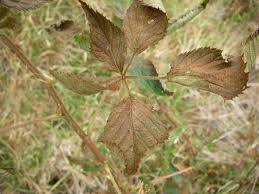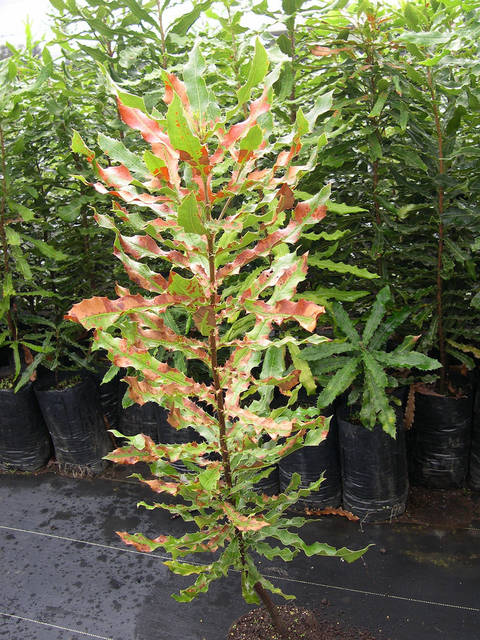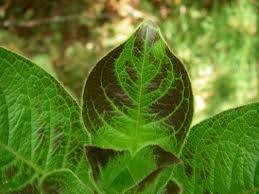Kris asks: I have noticed that the leaves on my ti plants are getting brown spots and turning yellow faster than usual. I wonder if this is due to the increase in vog in West Hawaii. If so, will other plants be affected if this air quality situation continues?
Tropical Garden Answer: Yes, many plants can be adversely affected by the sulfur dioxide (SO2) as well as by the ash produced during volcanic eruptions. The effects are less severe in places more distant from the eruption or where wind patterns prevent exposure. Here in Kona, strong trade winds can protect us to some degree though winds that blow around South Point can bring vog up the west coast to Kona.
Ti plants are not among the most sensitive plants to vog, but the presence of high levels of SO2 as well as the resultant acid rain can cause notable effects. These can include the spotting and chlorosis you are noticing. If we continue to get heavy vog in Kona, you may see negative effects on other plants as well.
Agricultural crops are often injured by exposure to high concentrations SO2. When levels are as high as 0.5 ppm for more than eight hours or from 1-4 ppm. for more than thirty minutes, sensitive plants including some beans and brassicas as well as lettuces, Swiss chard, endive and turnips will likely show leaf burn or necrosis. More resistant crops like asparagus, cabbage, celery, corn, onions, potatoes, coffee, fruit and ohia trees can tolerate SO2 levels up to 2 ppm for eight hours or even up to 10 ppm in durations of 30 minutes or less.
Sulfur dioxide enters plant tissue through the stomata on the underside of their leaves. When water stress, cool weather or overcast skies keep the stomata closed, plants may not be injured. However, if SO2 enters the leaf it combines with water and becomes sulfuric acid which burns the leaf tissue. The burning will usually manifest as brown, white or simply necrotic interveinal areas on the leaves. Young or tender leaves are usually more severely affected than older, tougher ones. Reducing watering may slightly reduce the ability of SO2 to enter the leaves.
In addition to gas emissions, the volcano also produces volcanic ash that gets deposited as dust on everything near the site, including plants. This ash is made up of fine rock particles that appear as the particulate matter visible in vog. It is only a severe problem for plants when it settles on the leaves and does not get removed quickly. Blowing the ash away is most effective. If you suspect that ash particles have settled on edible plant parts, be sure to wash them well before eating.
The acidic gases that are created during volcanic eruptions not only affect plants directly but also can cause acid rain. This forms when the sulfur molecules in the air combine with moist air producing sulfuric acid that can fall as acid rain or move across an area as acidified fog. The pH of acid rain downwind of an eruption can be less than 4.0 causing an increase in soil acidity affecting the availability of toxic heavy metals in the soil. The lower pH can also lower the fertility of the soil, causing direct damage to plant leaves and flowers and reducing growth and productivity rates. Plants will show signs of acid rain damage through interveinal leaf chlorosis or necrosis. If acid rain becomes a problem, flushing the soil with water or adding lime (a soil sweetening agent) may help. A tablespoon of baking soda in a half gallon of water can help “sweeten” soil for container plants or those in small garden areas.
Farmers and gardeners near the eruption as well as in Ka‘u and Ocean View have reported significant damage when northeasterly and southeasterly winds blow their way. We have not, and hopefully will not, see the severe effects on plants here in Kona that have occurred in areas directly downwind of the eruption. Monitor the emission levels in your area regularly to determine if you need to take protective measures for yourself or your plants.
For more information on vog injury to plants take a look at the CTAHR free publication on the subject at https://www.ctahr.hawaii.edu/oc/freepubs/pdf/pd-47.pdf.
Diana Duff is a plant adviser, educator and consultant living in a dryland forest north of Kailua-Kona.
Gardening Events
Saturday: “Work Day at Amy Greenwell Garden” from 9 a.m. to 12:30 p.m. Meet at the Garden Visitor Center across from the Manago Hotel in Captain Cook. Volunteers will be able to help with garden maintenance and are invited to bring a brown bag lunch. Water and snacks provided. Call Peter at 323-3318 for more information.
Farmer Direct Markets
Wednesday: “Ho’oulu Farmers Market” from 9 a.m. to 2 p.m. at Sheraton Kona Resort &Spa at Keauhou Bay
“Sunset Farmers Market” from 2-6 p.m. in the HPM parking lot at 74-5511 Luhia St. in Kailua-Kona (across from Target)
Saturday: “Keauhou Farmers Market” from 8 a.m. to noon at Keauhou Shopping Center
“Kamuela Farmer’s Market” from 7 a.m. to noon at Pukalani Stables
“Waimea Town Market” from 7:30 a.m. to noon at the Parker School in central Waimea
“Waimea Homestead Farmers Market” from 7 a.m. to noon at the Waimea Middle and Elementary School Playground
Sunday: “Pure Kona Green Market” from 9 a.m. to 2 p.m. at Amy Greenwell Garden in Captain Cook
“Hamakua Harvest” 9 a.m. to 2 p.m. at Highway 19 and Mamane Street in Honokaa
Plant Advice Lines
Anytime: konamg@ctahr.hawaii.edu
Tuesdays and Thursdays: 9 a.m. to noon at UH-CES in Kainaliu — 322-4893
Mondays and Fridays: 9 a.m. to noon at UH CES at Komohana in Hilo 981-5199 or himga@hawaii.edu








